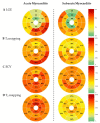Comprehensive Cardiac Magnetic Resonance to Detect Subacute Myocarditis
- PMID: 36079039
- PMCID: PMC9457022
- DOI: 10.3390/jcm11175113
Comprehensive Cardiac Magnetic Resonance to Detect Subacute Myocarditis
Abstract
(1) Background: Compared to acute myocarditis in the initial phase, detection of subacute myocarditis with cardiac magnetic resonance (CMR) parameters can be challenging due to a lower degree of myocardial inflammation compared to the acute phase. (2) Objectives: To systematically evaluate non-invasive CMR imaging parameters in acute and subacute myocarditis. (3) Methods: 48 patients (age 37 (IQR 28−55) years; 52% female) with clinically suspected myocarditis were consecutively included. Patients with onset of symptoms ≤2 weeks prior to 1.5T CMR were assigned to the acute group (n = 25, 52%), patients with symptom duration >2 to 6 weeks were assigned to the subacute group (n = 23, 48%). CMR protocol comprised morphology, function, 3D-strain, late gadolinium enhancement (LGE) imaging and mapping (T1, ECV, T2). (4) Results: Highest diagnostic performance in the detection of subacute myocarditis was achieved by ECV evaluation either as single parameter or in combination with T1 mapping (applying a segmental or global increase of native T1 > 1015 ms and ECV > 28%), sensitivity 96% and accuracy 91%. Compared to subacute myocarditis, acute myocarditis demonstrated higher prevalence and extent of LGE (AUC 0.76) and increased T2 (AUC 0.66). (5) Conclusions: A comprehensive CMR approach allows reliable diagnosis of clinically suspected subacute myocarditis. Thereby, ECV alone or in combination with native T1 mapping indicated the best performance for diagnosing subacute myocarditis. Acute vs. subacute myocarditis is difficult to discriminate by CMR alone, due to chronological connection and overlap of pathologic findings.
Keywords: CMR; ECV; LGE; Lake Louise criteria; T1 mapping; T2 mapping; acute myocarditis; magnetic resonance imaging; subacute myocarditis.
Conflict of interest statement
The authors declare no conflict of interest.
Figures




References
-
- Ferreira V.M., Schulz-Menger J., Holmvang G., Kramer C.M., Carbone I., Sechtem U., Kindermann I., Gutberlet M., Cooper L.T., Liu P., et al. Cardiovascular Magnetic Resonance in Nonischemic Myocardial Inflammation: Expert Recommendations. J. Am. Coll. Cardiol. 2018;72:3158–3176. doi: 10.1016/j.jacc.2018.09.072. - DOI - PubMed
-
- Caforio A.L.P., Pankuweit S., Arbustini E., Basso C., Gimeno-Blanes J., Felix S.B., Fu M., Heliö T., Heymans S., Jahns R., et al. Current state of knowledge on aetiology, diagnosis, management, and therapy of myocarditis: A position statement of the European Society of Cardiology Working Group on Myocardial and Pericardial Diseases. Eur. Heart J. 2013;34:2636–2648. doi: 10.1093/eurheartj/eht210. - DOI - PubMed
Grants and funding
LinkOut - more resources
Full Text Sources

